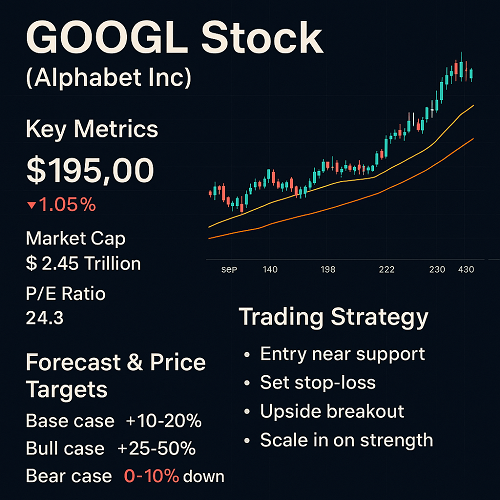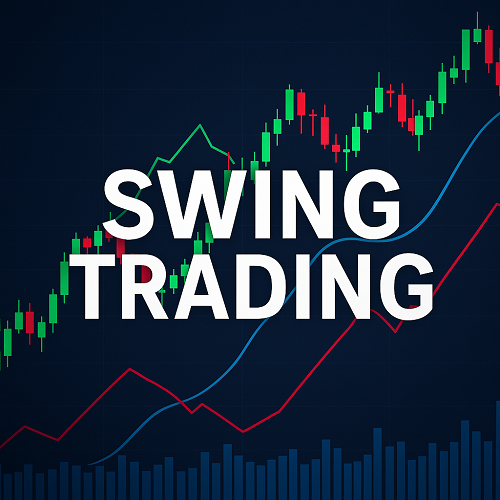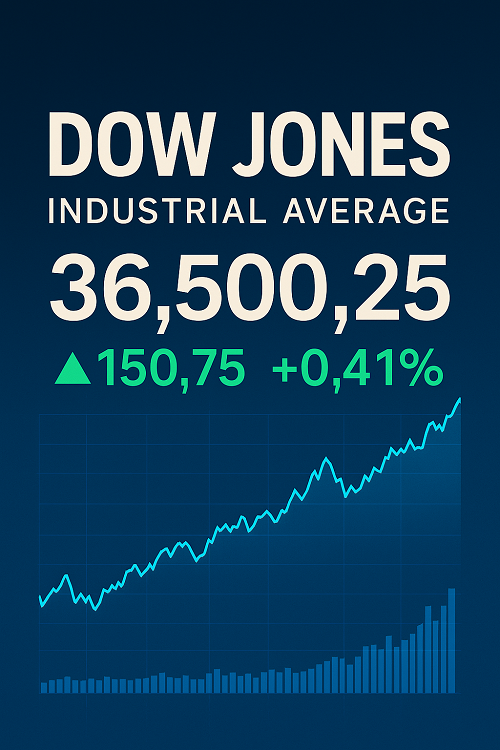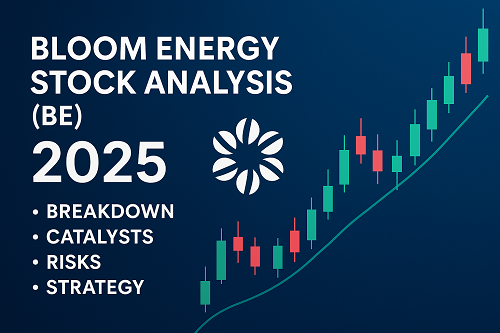When investors search “GOOGL stock” or “Alphabet Inc Class A shares”, they expect real-time quotes, performance trends, valuation metrics, and a forward view. The existing MarketWatch page delivers much of that, but often in a highly templated, summary format. Our aim here is to go deeper — bridging fundamental, technical, and strategic angles in a unified, readable, SEO-rich format.
Here are some of the latest key metrics (as of latest available data):
| Metric | Value |
|---|---|
| Ticker | GOOGL (Alphabet Inc Class A) |
| Exchange | NASDAQ |
| Sector / Industry | Communication Services / Internet Content & Information |
| Market Cap | ~ $3.0 trillion (depending on current price) |
| P/E (Trailing 12M) | ~ mid-20s range* |
| 52-week Range | Low ~ $140 – High ~ $256 |
| Dividend Yield | Nominal (Alphabet historically hasn’t prioritized dividends) |
| Institutional Ownership | High |
| Beta | ~1.0 – 1.2 (moderate volatility) |
* The P/E ratio fluctuates with earnings and price changes; always check updated data.
These metrics are similar to what tools like Finviz or Webull report.
But what really matters is how these numbers evolve, what underpins them, and how to anticipate future moves.
Business Overview & Revenue Streams
To understand GOOGL’s stock potential, we must dig into its business anatomy. Alphabet is not just “Google search.” Its structure is diversified and evolving:
Core segments
- Google Services
- Search & advertising
- YouTube (ads, subscriptions)
- Maps, Play Store, Gmail, etc.
- Google Cloud
- Infrastructure as a Service (IaaS)
- Platform and AI tools
- Enterprise solutions
- “Other Bets”
- Moonshot / experimental arms (Waymo, Verily, etc.)
- Hardware (Pixel, Nest)
- AI research initiatives
- AI & Future Tech Initiatives
- Gemini / AI models
- AI integrations in search, assistants, content
- Edge / on-device AI
Alphabet reorganized in 2015 to become a parent holding company, enabling greater autonomy in non-search ventures.
Strengths & Moats
- Scale & Data: Google’s search infrastructure and user base yield enormous data advantage in training AI models, ad targeting, and personalization.
- Ad Monopoly (with challenges): Despite regulatory scrutiny, Google maintains dominant positions in search and video monetization.
- Ecosystem lock-in: Android, Chrome, YouTube, Maps form a tight user ecosystem feeding ad revenues.
- Cloud growth & margins: Cloud is less margin-rich today than search ads, but growth potential is high.
- R&D and capital flexibility: Vast cash flows enable sustained investment in future technologies.
Weaknesses & Challenges
- Heavy dependency on advertising revenue; any disruption (privacy, regulation) has outsized impact.
- “Other Bets” have historically burned capital with uncertain payoff.
- Regulatory and antitrust overhangs (especially in the U.S. and EU).
- Competitive pressure from cloud peers (Microsoft Azure, AWS) and AI startups.
Recent Developments & Catalysts
To keep the narrative fresh (and SEO relevant), here are the recent strategic moves and news that shape stock orientation.
- Gemini AI evolution: There is speculation that Gemini might adopt features reminiscent of TikTok’s format to boost engagement, which could unlock new monetization paths.
- Regulatory Developments: Changes in antitrust regulation or enforcement on app store monopolies remain a latent risk.
- Cloud deals & enterprise adoption: Any major AI + cloud contract could accelerate investor confidence.
- AI push & monetization: How Alphabet commercializes generative AI, integrates it into ads, and captures margins will be a key frontier.
- Cost control / efficiencies: Investors may watch margin compression or operational optimizations in light of slowdowns.
A well-timed update of news and integrating it into the article gives it freshness and topical relevance — which helps with Google ranking.
Financial & Valuation Analysis
Let’s go deeper than what MarketWatch provides (income statement, balance sheet liners). Successful content often builds forecasts, margin sensitivity models, and valuation scenarios.
Recent Financials Snapshot
From MarketWatch’s “Financials” section:
- Revenue: Alphabet continues to grow year-over-year across its segments.
- Profitability: High gross margins, but “Other Bets” often dilute consolidated margins.
- Cash flows: Strong operating cash, meaning it can self-fund R&D and investments.
- Debt: Low relative to equity; capital structure is conservative.
Valuation Multiples & Metrics
Key multiples to compare:
- P/E (Trailing & Forward)
- P/S (Price to Sales)
- EV/EBITDA
- PEG (growth adjusted)
- Return on Equity / Assets
- Free Cash Flow Yield
- Discounted Cash Flow (DCF) Model
Sample DCF Sketch
To create a DCF, we can:
- Project free cash flow growth over 5–7 years (e.g. 10–15% annually, tapering).
- Estimate a terminal growth (e.g. 3–4%)
- Discount at weighted average cost of capital (WACC ~8–10%)
- Sum present values + net debt adjustments
Such a DCF might yield an intrinsic valuation slightly above or below current market price depending on growth assumptions. Providing multiple valuation scenarios (base, bull, bear) is valuable to sophisticated readers.
Sensitivity Analysis
Show how valuation changes if:
- Growth is slower (e.g. 8% instead of 12%)
- Terminal growth is more conservative
- Profit margins compress
This kind of sensitivity grid adds depth and differentiates your content from shallow summaries.
Technical Analysis & Chart Patterns
A top-ranking stock analysis article must include a strong technical section with interpretive commentary (not just charts). Here’s how to structure it.
Trend & Price Structure
- Identify the dominant trend (e.g. uptrend over multiple timeframes).
- Mark key support and resistance zones.
- Show prior price pivots and how they may act as future anchors.
Moving Averages & Indicators
- 50-day, 200-day MA crossovers
- Relative Strength Index (RSI) — overbought/oversold zones
- MACD, Bollinger Bands, and volume confirmation
- On-balance volume, accumulation/distribution
Patterns & Breakouts
- Triangles, flags, cups & handles, head & shoulders (if present)
- Price consolidations / breakout zones
- Trading ranges and volatility contraction zones
Example Interpretation
Suppose GOOGL is forming a rising wedge or narrowing range near a major resistance zone; a breakout above that could propel it to a next leg up, but a breakdown might risk a pullback to major support at $200–$220.
Providing annotated charts (or at least descriptions) helps readers visualize and strengthens SEO (through image alt text, captions, etc.)
Risk Management in Technicals
- Use stop-loss placement just below support zones
- Position sizing based on volatility
- Use trailing stops (e.g. moving average break)
- Scalping vs swing trade timeframes
Analyst Expectations & Sentiment
Investors often search “GOOGL analyst ratings,” “price targets,” “upgrades/downgrades.” Here you can aggregate and commentary.
- Aggregate Rating: e.g. “Buy” / “Outperform” consensus
- Range of Price Targets: High / median / low
- Recent Changes / Revisions
- Earnings Estimate Trends (EPS revisions)
- Insider Activity & Ownership
- Short Interest & Sentiment Data
Use up-to-date sources or integrate APIs / widgets (though content should remain evergreen).
Comparative Peers & Sector Positioning
GOOGL doesn’t exist in a vacuum. Compare with key peers and contextualize its competitive position.
Peer Group
- Microsoft (MSFT) — especially in cloud & AI
- Meta (META) — advertising, social, AI
- Amazon (AMZN) — cloud, retail, AI edges
- Nvidia (NVDA) — AI hardware, compute
- Other internet / ad / AI companies
Comparative Metrics Table
Compare valuation, growth, margins, and volatility. Highlight where GOOGL over/underperforms peers.
Sector & Thematic Positioning
- Role in “Big Tech / Magnificent Seven”
- How AI, cloud, advertising, data privacy regulation affects the group
- Diversification across segments vs peers’ specialization
This not only enriches your article but helps capture “GOOGL vs MSFT,” “GOOGL vs NVDA” etc search traffic.
Risks & Headwinds
No analysis is complete without a candid look at what can go wrong. Risk disclosure builds credibility and qualifies your projections.
- Regulatory and antitrust pressure
- Privacy & data regulation (e.g. GDPR, CCPA)
- Ad revenue cyclicality
- Competitive disruption (AI entrants, privacy-first platforms)
- “Other Bets” burn rate and opportunity cost
- Macroeconomic slowdown → ad spending cuts
- Execution risk: failing to monetize AI or integrate it
By clearly enumerating risks, you gain reader trust and mitigate claims of bias.
Scenario Forecasts & Price Targets
Here is where you synthesize fundamentals, technicals, and market context into projected scenarios:
| Scenario | Time Horizon | Assumptions | Price Target Range |
|---|---|---|---|
| Base case | 12 months | Moderate growth, stable margins | +10-20% upside |
| Bull case | 12–24 months | AI monetization accelerates, cloud takes off | +25-50% upside |
| Bear case | 6–12 months | Regulatory hit or earnings miss | Flat to –10% downside |
You can further break into shorter timeframes if your audience includes active traders.
Also consider probabilistic weighting (e.g. 60% base, 20% bull, 20% bear) to derive a “most likely” target range.
Trading Strategy & Tactics
This section is especially valuable for traders (not just investors). You can include:
Entry & Exit Strategies
- Timing entries near support or upon confirmed breakouts
- Scaling in vs all-in
- Exit triggers: technical signals, earnings, news events
Position Sizing & Risk Control
- Use volatility (ATR, etc.) to size positions
- Stop-loss strategies (percent, technical level, trailing)
- Risk:Reward ratio guidelines (e.g. 1:3)
Time Horizon Tactics
- Intraday / Swing traders: use shorter moving averages, volume spikes, momentum
- Medium term: carry through earnings, follow major news catalysts
- Long term: buy & hold, dollar cost average
Hedging & Options
- Use options strategies: protective puts, covered calls, spreads
- Hedging around earnings with straddles or collars
- Monitoring implied volatility and skew
Trade Journal & Review
- Encourage logging trades, analyzing mistakes
- Adjust strategies based on performance
This level of tactical depth helps you appeal to a spectrum of traders and sum up as a “playbook” for readers.
Conclusion & Outlook
To wrap up:
- GOOGL is one of the most important stocks in Big Tech — combining scale, AI potential, and monetization breadth.
- The near-term path hinges on how well Alphabet transitions into AI monetization, cloud expansion, and regulatory navigation.
- Traders should watch key technical zones and news catalysts; investors should evaluate valuation vs growth assumptions.
- Our scenario forecasts suggest a moderate upside in the next 12 months, but volatility risk is nontrivial.





 XAUT-USD
XAUT-USD  AMD
AMD  MARA
MARA  SHOP
SHOP  BULL
BULL  CL=F
CL=F